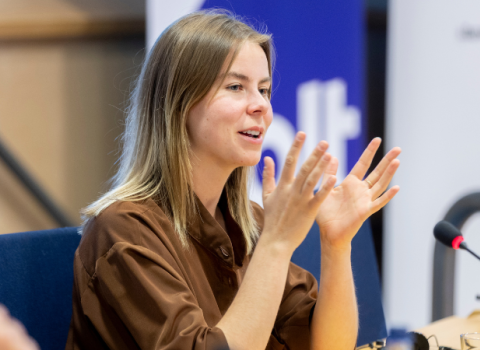Neurologist Kamila Markram and her research colleagues at the Swiss Federal Institute of Technology in Lausanne were fed up with the established order of scholarly publication. As post-doctorates launching their careers, they submitted one article after another to leading journals, most of the time receiving rejections and “nasty peer reviews,” Markram recalls.
Instead of despairing, the group decided to shake up the clubby world of academic publication and created Frontiers, a web-based open peer-review publishing platform for academics. Following its launch in 2007, Frontiers took off rapidly, as scientists around the world embraced the new open-access publishing model.
By 2013, the Frontiers journal series had expanded into 29 scientific disciplines and published more than 20,000 articles. Now ranked as the fifth largest open-access publisher, Frontiers has 45,000 active researchers sitting on its editorial boards and is doubling the number of articles published each year. Frontiers in Psychology, launched in 2010, has become the largest psychology journal worldwide.
“We needed a different way to publish and read. We needed an open-access platform to increase visibility and discoverability of the work researchers are doing,” said Markram. “The process of peer review should be rigorous, constructive, fair, transparent and efficient – so all can profit from discovery as fast as possible.”
Markram’s journey from frustrated scientist to successful entrepreneur was one of three case studies presented in a Science-to-Business session, ‘I owe my company to frustration’ at the 2014 EuroScience Open Forum in Copenhagen in June. All three cases focused on companies created to change the way science is created, evaluated and communicated, tapping open-access platforms to increase visibility and access to research.
“We are a technology company at heart,” said Markram, who is co-founder and chief executive officer. “We built a collaborative peer review forum, democratic evaluation, open access network, and a way to popularise science.” Frontiers has become so successful at disrupting the traditional publication model that the journal Nature struck an alliance with Frontiers in 2013 to further open science.
Shout about your research
Stem cell biologist Mark Hahnel had a different set of frustrations. While working on his PhD at Imperial College London, he was producing huge volumes of data linked to his work, including spreadsheets and videos. But most of the data were not being published because they did not fit in the traditional publication format. “If you are funding research and you pay $1 billion for a project that just generates papers, is that the true sum of the research?” Hahnel asked.
The answer was no, he decided. “I was doing all this hard work, coming into the lab on Saturday mornings – and I wanted to make the findings open and available. If you want to rise to the top in academia, you have to shout about your research.” His goal was to make all the data easily “citable, shareable and discoverable.”
With financial support from Macmillan Digital Science, Hahnel founded Figshare, a digital platform designed to make vast volumes of research data easy to publish and access. “Publishers are getting to the point where they are saying, let’s enhance the content so it is more useful,” Hahnel said. “Three hundred years ago, scientists were sharing papers. Getting on an iPad and sharing papers is not the fastest way to share content in research – it’s not all of the story.”
Making search more intelligent
But some data repositories are just too enormous to sift through. Social scientist Dave Copps, founder and CEO of Brainspace Corporation, decided to create the first global semantic network for science professionals. A self-proclaimed “search geek,” he found most search systems too cumbersome to use – and wished they could do more.
“I think search is fundamentally broken on many levels,” said Copps. “Only 50 per cent of search is successful. It’s not only because search tools are not great, it’s because data [volumes] are much bigger – that’s become a big problem.”
Inspired by the potential of big data to transform the search experience for scientists, Copps decided to build a system that would “learn” as it reads documents, create artificial intelligence on what is was reading, and use that knowledge to connect people. “The idea was to build a brain and give people access to it,” he said. It connects people based on their knowledge and research on who should be talking to each other.”
Copps’ new network, BrainspaceScience, aims to transform the published works of scientists into a collective intelligence that can be used by science professionals around the world.
Markram, Hahnel and Coops all agreed the lessons they learned as entrepreneurs were positive. “I love science, but I also love having the opportunity to disseminate science,” said Markram, who launched her business in part because to earn money, but realised along the way that her business would have a greater impact on science than the work in her lab.
Copps, a serial entrepreneur who has founded three companies, noted both scientists and entrepreneurs are “comfortable stepping into the unknown,” and he encouraged delegates to “just get out and do it.”




 A unique international forum for public research organisations and companies to connect their external engagement with strategic interests around their R&D system.
A unique international forum for public research organisations and companies to connect their external engagement with strategic interests around their R&D system.